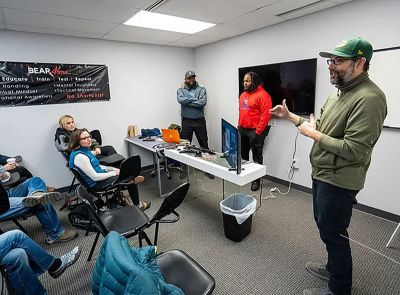On a recent January Saturday, Dr. James Bigham commemorated the two-year milestone of his firearm injury prevention course at Max Creek Outdoors in Oregon, Wisconsin. This course, launched to mitigate firearm injuries, is part of a visionary initiative he started in 2023 to foster cultural competency and empower health care professionals in firearm injury prevention discussions.

Dr. James Bigham (foreground) works with experts at Bear Arms in Mequon to teach a firearm injury prevention course to health care professionals.
The monthly sessions, designed for medical students, residents, and faculty, include two hours of instruction on different types of guns, ammunition, and securing devices like cable locks, trigger locks, and gun safes. After the session, participants are invited to operate a firearm at Max Creek’s indoor range. For many, it’s their first encounter with a firearm. This experience often leads to a new appreciation of how partnerships with gun shops can help prevent firearm injuries.
“Our course demystifies firearms without glorifying them. We create a safe space for questions, helping those who care for patients with firearms but lack personal experience,” says Bigham. “Before the session, 60 percent of participants felt uncomfortable screening and counseling on firearm injury prevention. After our two-hour program, 95 percent feel confident or very confident.”
The Importance of Partnership
The tragic school shooting at Sandy Hook Elementary School in Newtown, Connecticut, made Bigham realize the urgent need to implement effective approaches to reduce firearm risk in the community. Lacking exposure to firearm injury prevention during his medical school and residency training, he saw an opportunity to make a difference and eagerly accepted the chance to co-author a paper urging Wisconsin health systems to adopt strategies for reducing firearm injury risk among patients.
Following the publication of the article, Bigham was invited to participate in a webinar for the Dane County Ending Deaths from Despair initiative in November 2022. The talk, “Lock, Stock and Barrel,” provided an opportunity to discuss how clinicians and gun shop owners can collaborate on suicide prevention.
His co-presenter, gun shop owner Chuck Lovelace, described The Gun Shop Project, an innovative program where gun shops voluntarily hold firearms for individuals experiencing a mental health crisis. This free service helps restrict access to lethal means and prevent firearm-related deaths.
“Chuck and I quickly found common ground, and I realized I had overlooked the potential role of gun shops in injury prevention,” shares Bigham. This experience sparked his interest in collaborating with partners within the gun culture.
Encouraged by the success of the webinar, Bigham connected with Steve D’Orazio, the owner of Max Creek Outdoors. In January 2023, they launched their first training session for learners at the shop.
Working with Patients
Bigham practices universal screening by incorporating questions about firearm access into his social history inquiries using a curious and non-judgmental approach. In his practice, Bigham starts with less intimate topics, such as tobacco use, and gradually moves to more personal subjects, ending with firearm access. He asks open-ended questions like, “I wanted to check in to see if you have access to firearms?”
If patients confirm they have access to firearms, Bigham follows up with questions about secure storage and preventing unauthorized access, such as, “How are you making sure the kids don’t have access?” He listens closely, applauds their efforts to reduce risk, and gently offers suggestions for enhancing risk reduction. He often refers patients to local gun shops for gun safes or lock boxes and encourages range training. If needed, he provides trigger or cable locks during their visit.
After learning that over 70 percent of firearm deaths in Wisconsin are suicides, Bigham started checking in to see if patients have a plan in place in the event of a mental health crisis.
“Many haven’t considered a plan for a mental health crisis, so I suggest a voluntary transfer to a friend, loved one, or one of the 40-plus gun shops in Wisconsin that hold firearms for free until it’s safe to have them back,” shares Bigham. “This has led to fruitful conversations, with many patients appreciating the chance to have a collaborative discussion about how to reduce their risk of self-harm.”
Focus on Injury Prevention
Bigham believes the role of the physician is to help support patients in realizing optimal health, including strategies to reduce their risk of injuries. For patients who own a car, physicians often counsel on seatbelts, not driving while impaired, and avoiding texting and driving. The same techniques can be used when discussing firearms.
According to Bigham, physicians play a crucial role in advocacy. He emphasizes the importance of conducting research on firearms and firearm-related injury risks to provide evidence-based guidance to patients. Additionally, some physicians may use this knowledge to assist lawmakers in creating policies and legislation that reduce the risk of firearm injuries in our communities while preserving the legal right to responsibly own firearms.
“We can counsel patients with firearms on secure storage, proper use to prevent accidental discharge, and having a plan for voluntary transfer during a mental health crisis or if there’s an at-risk person at home,” says Bigham. “This can be done without taking a position on firearm ownership, which is a personal choice.”
For more information on Bigham’s firearm injury prevention course, contact james.bigham@wisc.edu with the subject Lock, Stock and Barrel.
Related video: Firearm Injury Prevention: Clinical Skills
Published: February 2025
